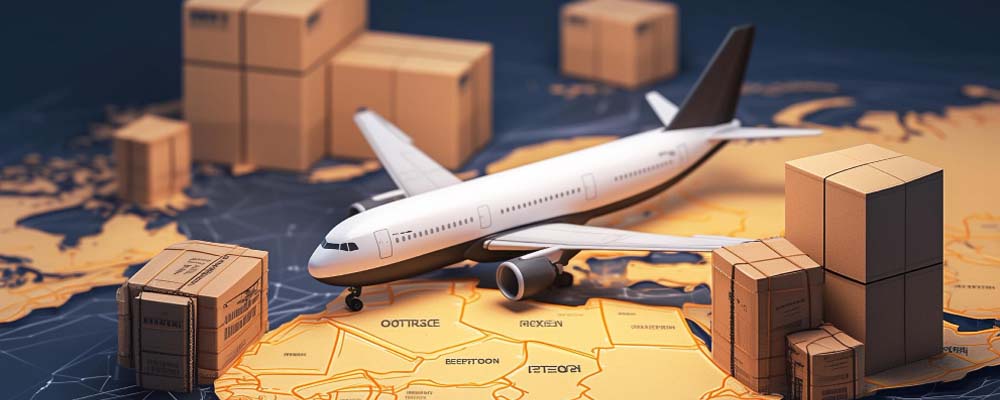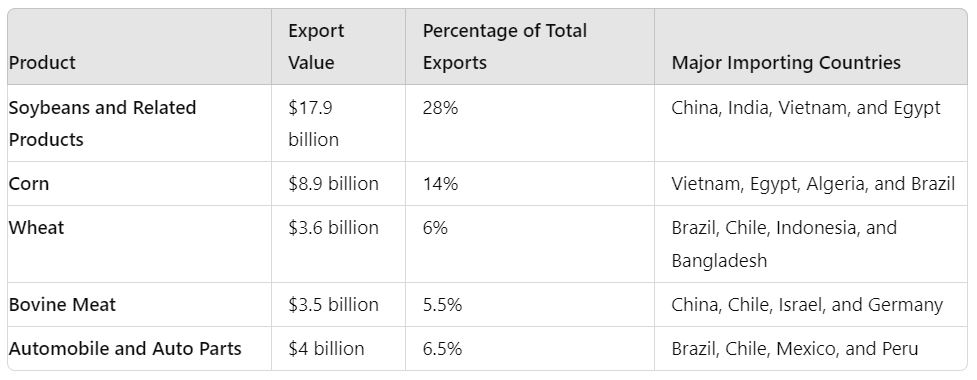
Argentina actively plays a key role in global trade, leveraging its rich natural resources and agricultural strength. Agricultural products like soybeans, corn, wheat, and bovine meat dominate its export portfolio. Meanwhile, Argentina meets its industrial and energy needs through strategic imports like machinery, vehicles, petroleum, pharmaceuticals, and plastics.
This blog explores Argentina’s top exports and imports, highlighting the critical commodities shaping its trade dynamics. By examining these patterns, businesses can identify opportunities for growth and investment while gaining valuable insights into Argentina’s economic landscape and global trade position.
Main Exports of Argentina
Soybeans and Related Products
Soybeans are the cornerstone of Argentina’s export economy, making a significant contribution to its GDP. In 2023, Argentina exported soybeans and related products worth approximately $17.9 billion, accounting for nearly 28% of its total exports. China is the dominant importer, taking in the largest share of Argentina’s soybean exports, followed by India, Vietnam, and Egypt. Soybeans are a critical component of the global food and biofuel industries, positioning Argentina as a major supplier due to its vast agricultural resources and favorable climate for cultivation.
Corn
Corn is another key agricultural product in Argentina’s export portfolio. In 2023, the country exported corn valued at $8.9 billion, representing about 14% of its total exports. Major importers include Vietnam, Egypt, Algeria, and Brazil. As a staple food and animal feed, corn is essential to global agriculture and food production. Argentina’s fertile pampas region ensures a robust supply, making it one of the world’s leading corn exporters.
Wheat
Wheat plays an important role in Argentina’s export market, with the country exporting wheat worth $3.6 billion in 2023, which amounts to 6% of total exports. Brazil, Chile, Indonesia, and Bangladesh are among the primary destinations for Argentine wheat. With its strategic position in the Southern Hemisphere, Argentina provides vital supplies to global markets during counter-seasonal periods, enhancing its importance in the global grain trade.
 Bovine Meat
Bovine Meat
Argentina is globally renowned for its high-quality beef, and bovine meat exports are a significant contributor to its economy. In 2023, Argentina exported bovine meat worth $3.5 billion, accounting for 5.5% of its total exports. China is the largest importer, followed by Chile, Israel, and Germany. Argentina’s reputation for premium beef and its robust cattle industry place it among the top global suppliers of this highly demanded commodity.
Automobiles and Auto Parts
The automotive sector is a major industrial export for Argentina, contributing $4 billion to the country’s exports in 2023, or about 6.5% of the total export value. Brazil, Chile, Mexico, and Peru are the key markets for Argentine automobiles and auto parts. Argentina’s automotive industry plays a pivotal role in the regional supply chain, particularly within South America, where it enjoys strong demand due to its established manufacturing capabilities and proximity to major markets.
Strategy and Analysis of Argentina Exports
Understanding the strategy behind Argentina’s export success is essential for industry stakeholders. The country’s focus on optimizing its vast agricultural resources, investing in technology to enhance production efficiency, and cultivating strong trade relationships with key global markets has been pivotal. Argentina’s strategic emphasis on high-quality agricultural products like soybeans, corn, and beef ensures a competitive edge, while its efforts to diversify exports, such as automobiles and machinery, contribute to economic resilience. This approach not only drives economic growth but also secures consistent demand for Argentina’s exports in international markets.
Main Imports of Argentina
Machinery and Equipment
Machinery and equipment form the largest segment of Argentina’s imports, essential for its industrial and agricultural sectors. In 2023, Argentina imported machinery and equipment worth approximately $12 billion, representing around 19% of its total imports. The United States, China, Brazil, and Germany are the key suppliers. These imports include industrial machines, electrical equipment, and mechanical devices, which are critical for modernizing Argentina’s infrastructure and supporting its manufacturing and farming industries.
 Vehicles and Auto Parts
Vehicles and Auto Parts
Argentina is heavily reliant on imported vehicles and auto parts to meet domestic demand. In 2023, vehicle and auto part imports reached $8.5 billion, accounting for about 13.5% of the country’s total imports. Brazil, Mexico, Germany, and Japan are the primary exporters. The majority of these imports are used to supply the automotive market and sustain Argentina’s growing transportation needs, especially as it seeks to support local manufacturing with foreign components.
Petroleum and Refined Products
Despite being a major exporter of agricultural goods, Argentina imports a significant amount of petroleum and refined products to meet its energy demands. In 2023, Argentina’s imports in this sector totaled $7 billion, making up nearly 11% of total imports. Brazil, the United States, and Bolivia are among the main sources of these energy imports. Petroleum imports are crucial for Argentina’s industrial sector and transportation, particularly during periods of domestic shortfalls in production.
Pharmaceuticals
Pharmaceuticals are vital to Argentina’s healthcare system, and the country imports a wide array of medical products. In 2023, pharmaceuticals imports reached $4.3 billion, accounting for approximately 7% of total imports. The leading suppliers are the United States, Germany, Switzerland, and Brazil. The importation of medicines, vaccines, and medical supplies is essential to maintaining the healthcare infrastructure and meeting the country’s growing medical needs.
Plastics and Plastic Products
Plastics and plastic products are crucial for various sectors of Argentina’s economy, including packaging, construction, and manufacturing. In 2023, Argentina imported plastics worth $3.8 billion, representing around 6% of its total imports. China, Brazil, the United States, and Germany are the main exporters. These products are used across multiple industries, from food packaging to automobile parts, and are essential for Argentina’s industrial and consumer markets.
Strategy and Analysis of Argentina Imports
Argentina’s import strategy is centered around addressing the country’s industrial, energy, and healthcare demands. By importing essential machinery and equipment, vehicles, petroleum and refined products, pharmaceuticals, and plastics, Argentina ensures the continuous development of its key sectors. These imports play a vital role in supporting the country’s infrastructure, enabling technological advancements, and ensuring energy security. Additionally, the importation of medical supplies and pharmaceuticals is crucial for meeting the healthcare needs of the population. This strategic approach to imports underpins Argentina’s efforts to modernize its economy, promote industrial growth, and sustain essential public services.
 Conclusion
Conclusion
Argentina’s trade dynamics highlight how the country leverages its agricultural resources and strategic imports to strengthen its economy. For freight forwarders, logistics providers, importers, exporters, and manufacturers, understanding these patterns is crucial for optimizing supply chains and seizing market opportunities.
The balance between Argentina’s key exports—such as soybeans, corn, wheat, and automobiles—and imports of machinery, vehicles, and petroleum showcases its strong trade framework. These imports support key sectors, while exports solidify Argentina’s position as a global food supplier.
Partnering with experts can help businesses navigate Argentina’s trade environment and succeed in this competitive market.





 Bovine Meat
Bovine Meat
 Vehicles and Auto Parts
Vehicles and Auto Parts Conclusion
Conclusion



